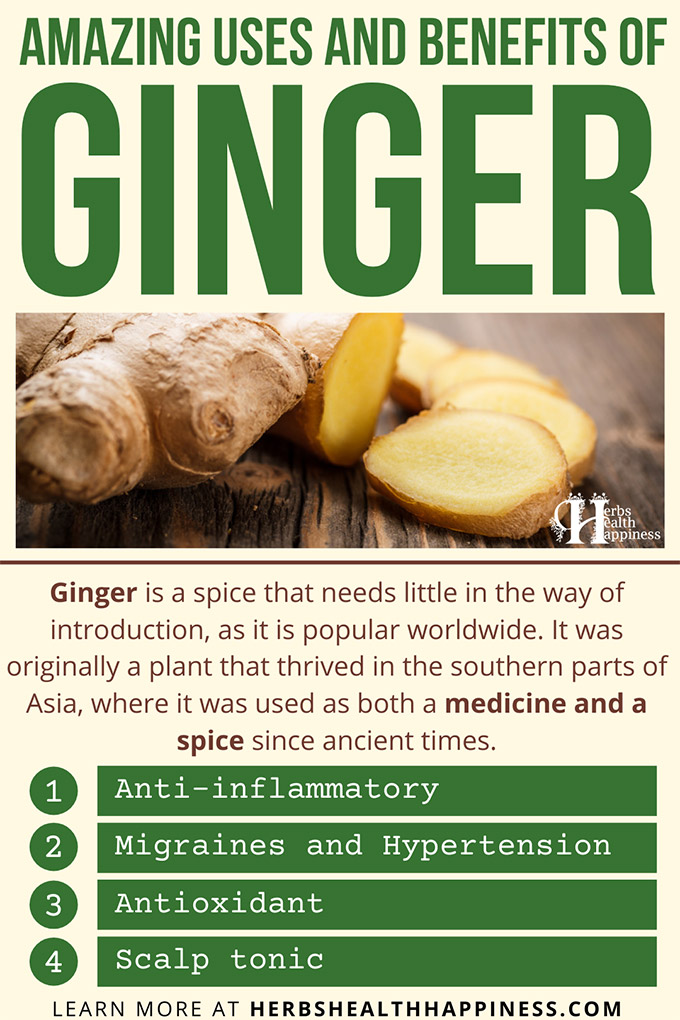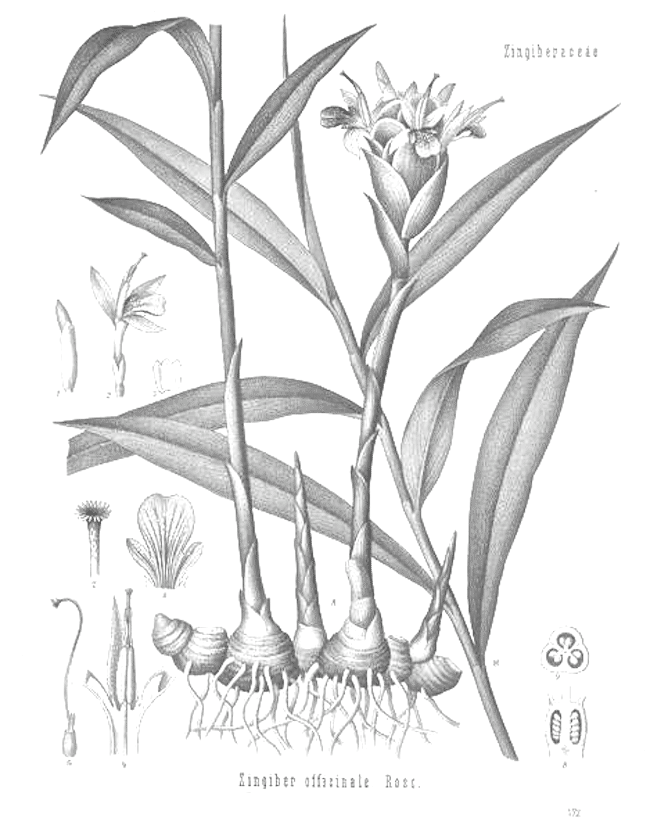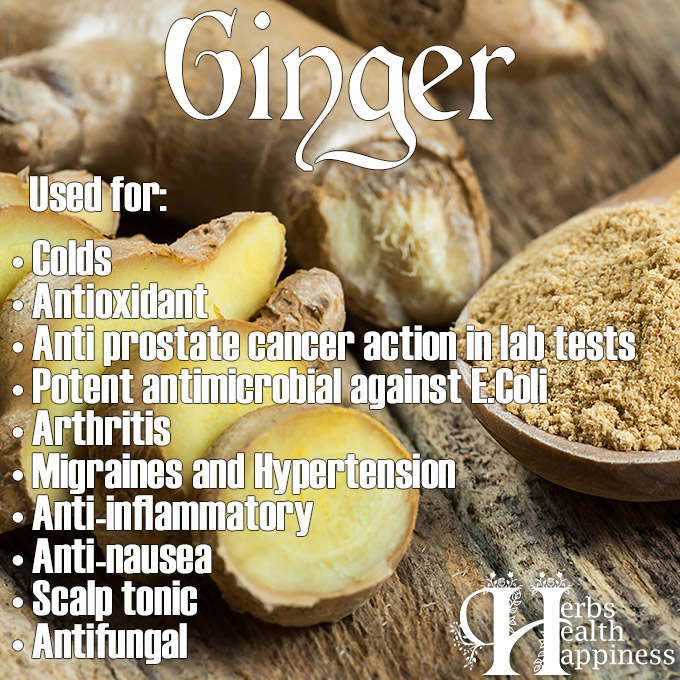Please follow us on Telegram to be sure to receive our latest posts!

Uses And Benefits Of Ginger. Graphic © herbshealthhappiness.com. Photo © AdobeStock (under license)
Ginger Video Transcript:
Ginger is a spice that needs little in the way of introduction, as it is popular worldwide. It was originally a plant that thrived in the southern parts of Asia, where it was used as both a medicine and a spice since ancient times.
Used for:
• Colds
• Antioxidant
• Anti prostate cancer action in lab tests
• Potent antimicrobial against E.Coli
• Arthritis
• Migraines and Hypertension
• Anti-inflammatory
• Anti-nausea
• Scalp tonic
• Antifungal
Perhaps the most common use of ginger root is in the creation of ginger tea, which is simply made with thinly sliced ginger in a cup and boiling water. Add honey and lemon!
When dried, it can be ground into a powder and mixed into foods.
Ginger is sometimes cultivated as a garden or landscape plant due to its colourful flowers and its overall aesthetic appeal.
Ginger is an anticancer food: In 2013 scientists discovered that 6-Shogaol, a major component of ginger, induces apoptosis (cell death) in human leukemia cells both in vitro and in vivo – without side effects!
Source: https://molecular-cancer.biomedcentral.com/articles/10.1186/1476-4598-12-135
Try the classic “ACG” – Apple Carrot Ginger – for a delicious blend that you will feel nourishing your system like water nourishes the roots of a tree. You could also add beet and/or lemon juice to add further nutrition and zing!
A 2014 study showed the effectiveness of ginger supplementation in protecting against oxidative stress – an intervention that is beneficial for obese people.
Source: https://www.sciencedirect.com/science/article/pii/S1728869X14000045
Ginger – Background & Uses
Native to Zanzibar, ginger is the rhizome of the plant Zingiber officinale. [1]
Hot ginger tea has been used for centuries by practitioners of Chinese medicine as a remedy for respiratory ailments, fatigue, and poor circulation. The phytonutrients in ginger replenish nutrients in the body while the high temperature of the liquid and the gingerol activity relieve stomach discomfort, fever, and congestion. [2]
Ginger is believed to be an effective natural remedy for Carpal Tunnel Syndrome. It is considered to be effective in lowering cholesterol and reducing the likelihood of type 2 diabetes. [3] However, these claims have not been verified according to modern science.
As a digestive aid, fever-reducer, expectorant, decongestant, antioxidant, immune-booster, mild painkiller, and antibacterial agent, ginger has been considered a cure-all by practitioners of traditional and alternative medicine. [4]
Ginger – Scientific Studies
Ginger – whether fresh, dried, pickled, preserved, candied, powdered, or crystallized – has been purported to exert a long battery of therapeutic and preventive actions and has been comprehensively studied as regards its efficacy against various pathologic conditions, hence its century-long utility in the management of a number of maladies such as colds, nausea, arthritis, migraine, and hypertension. Several scientific investigations have found evidence with respect to ginger being a potent antioxidant, anticancer, anti-inflammatory, and antinausea agent. [6]
To determine its potential to prevent certain cancers, gingerol–the active component in ginger–has been the focus of clinical trials. Researchers determined that in cases of ovarian cancer, administration of gingerol contributed to cancer-cell death. In cases of ovarian cancer, gingerol was found to reduce inflammation and boost immune function. Researchers have found that Gingerol might protect against colon cancer. [7]
Ginger as antimicrobial: In 2005, an American study compared the antimicrobial activity of garlic, carrot, turmeric, and ginger pastes against Escherichia coli O157:H7 in laboratory buffer and model food system. As revealed by the results of this study, commercial ginger paste exhibited the strongest antimicrobial activity, totally inactivating E. coli O157:H7 in the paste at 3 days at 4°C and 8°C. The commercial ginger paste also showed antimicrobial activity in buffered peptone water at 4°C for 2 weeks. [9] Moreover, the gingerols in ginger root extracts inhibit the growth of Helicobacter pylori CagA+ strains in vitro, as illustrated by another US study in which the methanol extract of ginger rhizome suppressed the growth of all 19 strains in vitro, the minimum inhibitory concentration range being 6.25–50 μg/mL. [8]
Ginger as anti-inflammatory, pain reliever & anti-arthritic: Ginger has long been considered as an effective anti-inflammatory agent that suppresses prostaglandin synthesis through the inhibition of both cyclooxygenase-1 (COX-1) and cyclooxygenase-2 (COX-2). [19] However, the results from the study of van Breemen, Tao, and Li (2011) reveal slightly otherwise and contend that purified 10-gingerol, 8-shogaol, and 10-shogaol suppress COX-2 – but not COX-1 – with IC50 values of 32μM, 17.5μM, and 7.5μM. [10] Ginger’s anti-inflammatory mechanism of action is very similar to that of today’s non-steroidal anti-inflammatory drugs (NSAIDs), but ginger goes one step ahead of NSAIDs in being able to suppress leukotriene biosynthesis also by inhibiting 5-lipoxygenase. [9]
The pungent constituent of ginger, 6-gingerol, possesses analgesic and anti-inflammatory effects, as proven by Young et al. (2005) in their study, and thus contributes to ginger’s anti-inflammatory action. [11] Another important anti-inflammatory mechanism of ginger is its inhibitory influence on the induction of many genes associated with the inflammatory response, such as those encoding cytokines, chemokines, and cyclooxygenase-2. [9] Ramadan, Al-Kahtani, and El-Sayed (2011) had also demonstrated the anti-inflammatory action of ginger, significantly inhibiting the incidence and severity of arthritis by decreasing the production of proinflammatory cytokines and activating the antioxidant defense system at a dose of 200 mg/kg body weight. [12]
Ginger as antioxidant and anti-cancer agent: A number of studies have reported the chemopreventive and antineoplastic effects of ginger, implicating its effectiveness in diverse biological actions, including free radical scavenging, influence on antioxidant pathways, alteration of gene expressions, and induction of apoptosis which in turn decrease tumor initiation, promotion, and progression. [13] In 2012, a US study in the British Journal of Nutrition had determined that daily ginger extract consumption (at a dose of 100 mg/kg body weight) inhibits the growth and progression of human prostate cancer cell line (PC-3) xenografts by 56% but spares normal rapidly dividing tissues, such as gut and bone marrow, from any growth-inhibitory and death-inductory effects. [14]
6-Gingerol induces cell death in human promyelocytic leukemia (HL-60) cells through its mediating activities on reactive oxygen species such as hydrogen peroxide and the superoxide anion and causes DNA fragmentation and inhibits Bcl-2 expression in HL-60 cells. [15] 6-Shogaol and 6-gingerol possibly possess anti-invasive properties against hepatoma cells through the regulation of MMP-9 and TIMP-1. Furthermore, 6-shogaol could further regulate urokinase-type plasminogen activity. [16]
Old Drawing Of Ginger Plant

Other names for Ginger, past or present:
English – Gingifere
Latin – Zingiber officinale
Greek – Zingiberis
French – Gingembre
German – Ingwer
Spanish – Jenbibre
Italian – Zenzero
Chinese (Mandarin) – Jiang; Sheng jiang
Japanese – Shoga, Jinja, Myoga
Korean – Kon-gang, Geon-gang, Jinjeo, Chinjo, Saenggang
Indonesian – Aliah, Jae, Lia
Hindi – Adrak, Adrakh; Sonth, Saunth
[1] Ginger. Wikipedia.
[2] Balch, Phyllis A. Prescription for Herbal Healing: An Easy-to-Use A-Z Reference to Hundreds of
Common Disorders and Their Herbal Remedies. 2002. Penguin Putnam NY.
[3] Peirce, Andrea. The American Pharmaceutical Association practical guide to natural medicines 1999. Stonesong Press, Inc. New York.
[4] Khalsa, Karta Purkh Singh and Michael Tierra. 2008. The Way of Ayurvedic Herbs: The Most Complete Guide to Natural Healing and Health with Traditional Ayurvedic Herbalism. Lotus Press: Twin Lakes, WI.
[5] Peirce, Andrea. The American Pharmaceutical Association practical guide to natural medicines 1999. Stonesong Press, Inc. New York.
[6] Bode A. M. & Zigang D. (2011). The Amazing And Mighty Ginger. In Benzie I. F. F. & Wachtel-Galor S. (Ed.), Herbal medicine: Biomolecular and clinical aspects (2nd ed.). Boca Raton, FL: CRC Press. Retrieved 4 March 2013 from https://ncbi.nlm.nih.gov/books/NBK92775/
[7] Gupta S. & Ravishankar S. (2005). A comparison of the antimicrobial activity of garlic, ginger, carrot, and turmeric pastes against Escherichia coli O157:H7 in laboratory buffer and ground beef. Foodborne Pathogens and Disease, 2(4): 330–340. Retrieved 4 March 2013 from https://pubmed.ncbi.nlm.nih.gov/16366855
[8] Mahady G. B., Pendland S. L., Yun G. S., Lu Z. Z., Stoia A. (2003). Ginger (Zingiber officinale Roscoe) and the gingerols inhibit the growth of Cag A+
strains of Helicobacter pylori. Anticancer Research, 23(5A): 3699–3702. Retrieved 4 March 2013 from https://pubmed.ncbi.nlm.nih.gov/14666666
[9] Grzanna R., Lindmark L., & Frondoza C. G. (2005). Ginger – an herbal medicinal product with broad anti-inflammatory actions. Journal of Medicinal Food, 8(2): 125–132. Retrieved 4 March 2013 from https://pubmed.ncbi.nlm.nih.gov/16117603
[10] van Breemen R. B., Tao Y., & Li W. (2011). Cyclooxygenase-2 inhibitors in ginger (Zingiber officinale). Fitoterapia, 82(1): 38–43. doi:
10.1016/j.fitote.2010.09.004. Retrieved 4 March 2013 from https://pubmed.ncbi.nlm.nih.gov/20837112
[11] Young H. Y., Luo Y. L., Cheng H. Y., Hsieh W. C., Liao J. C., & Peng W. H. (2005). Analgesic and anti-inflammatory activities of [6]-gingerol. Journal of Ethnopharmacology, 96(1–2): 207–210. Retrieved 4 March 2013 from https://pubmed.ncbi.nlm.nih.gov/15588672
[12] Ramadan G., Al-Kahtani M. A., & El-Sayed W. M. (2011). Anti-inflammatory and anti-oxidant properties of Curcuma longa (turmeric) versus Zingiber officinale (ginger) rhizomes in rat adjuvant-induced arthritis. Inflammation, 34(4): 291–301. doi: 10.1007/s10753-010-9278-0. Retrieved 4 March 2013 from https://pubmed.ncbi.nlm.nih.gov/21120596
[13] Baliga M. S. et al. (2011). Update on the chemopreventive effects of ginger and its phytochemicals. Critical Reviews in Food Science and Nutrition, 51(6):
499–523. doi: 10.1080/10408391003698669. Retrieved 4 March 2013 from https://pubmed.ncbi.nlm.nih.gov/21929329
[14] Karna P. et al. (2012). Benefits of whole ginger extract in prostate cancer. British Journal of Nutrition, 107(4): 473–484. doi: 10.1017/S0007114511003308. Retrieved 4 March 2013 from https://pubmed.ncbi.nlm.nih.gov/21849094
[15] Wang C. C., Chen L. G., Lee L. T., & Yang L. L. (2003). Effects of 6-gingerol, an antioxidant from ginger, on inducing apoptosis in human leukemic HL-60 cells. In Vivo, 17(6): 641–645. Retrieved 4 March 2013 from https://pubmed.ncbi.nlm.nih.gov/14758732
[16] Weng C. J., Wu C. F., Huang H. W., Ho C. T., Yen G. C. (2010). Anti-invasion effects of 6-shogaol and 6-gingerol, two active components in ginger, on human hepatocarcinoma cells. Molecular Nutrition & Food Research, 54(11): 1618–1627. doi: 10.1002/mnfr.201000108. Retrieved 4 March 2013 from https://pubmed.ncbi.nlm.nih.gov/20521273
Main article: Kelsey Wambold. Scientific Studies report: Dan Ablir © herbshealthhappiness.com

Uses And Benefits Of Ginger
Graphic © herbshealthhappiness.com. Photo © Shutterstock (under license)
😳 What Tinnitus Does To Your Brain Cells (And How To Stop It)
After 47 years of studies and countless brain scans done on more than 2,400 tinnitus patients, scientists at the MIT Institute found that in a shocking 96% of cases, tinnitus was actually shrinking their brain cells.
As it turns out, tinnitus and brain health are strongly linked.
Even more interesting: The reason why top army officials are not deaf after decades of hearing machine guns, bombs going off and helicopter noises…
Is because they are using something called "the wire method", a simple protocol inspired by a classified surgery on deaf people from the 1950s...
★ How To Get Rid Of Nail Fungus:
★ Does Your Salad Contain This Vegetable?
★ 20 Natural Painkillers In Your Kitchen (Video):
★ Men's Prostate Health:

2. Famous Chef Sheds 60lbs Researching New Paleo Recipes: Get The Cookbook FREE Here
3. #1 muscle that eliminates joint and back pain, anxiety and looking fat
4. 7 odd foods that KILL your abdominal fat (surprising fat-fighters)
5. The TRUTH about bread (Will surprise you!)
6. [PROOF] Reverse Diabetes with a "Pancreas Jumpstart"
7. Here's What Happens When You "Unlock Your Hip Flexors"
8. The #1 WORST food that CAUSES Faster Aging (beware -- Are you eating this?)
The #1 Muscle That Eliminates Joint And Back Pain, Anxiety And Looking Fat
By Mike Westerdal CPT
Can you guess which muscle in your body is the #1 muscle that eliminates joint and back pain, anxiety and looking fat?
This is especially important if you spend a significant amount of time sitting every day (I do, and this really affects me in a big way!)
Working this "hidden survival muscle" that most people are simply not training because no-one ever taught them how will boost your body shape, energy levels, immune system, sexual function, strength and athletic performance when unlocked.
If this "hidden" most powerful primal muscle is healthy, we are healthy.
Is it...
a) Abs
b) Chest
c) Glutes
d) Hip Flexors
Take the quiz above and see if you got the correct answer!
P.S. Make sure you check out this page to get to know the 10 simple moves that will bring vitality back into your life:
If you enjoyed this page:













Ginger is one plant, Turmeric is another one of 500 in the same species. We are using both of them along with other Thai medicinal Herbs for treatment, reversal, healing of various Pain, range of motion limitation like Frozen Shoulder, other. These Herbs have been applied for Centuries in Thailand, unfortunate due to convenience only few Spa’s use fresh Herbs. Yet it is fresh Herbs that provide optimum healing results.